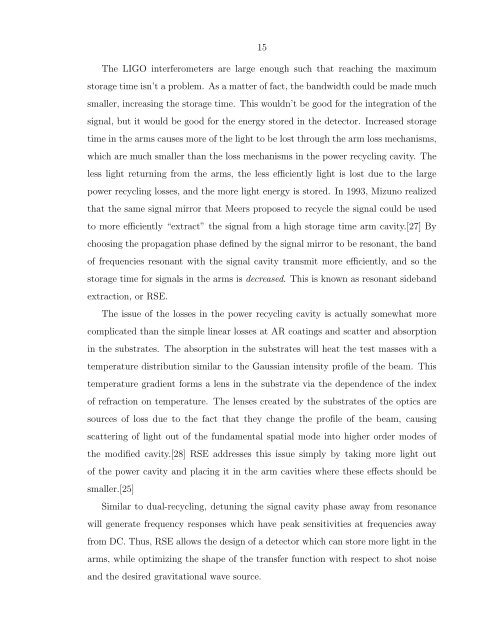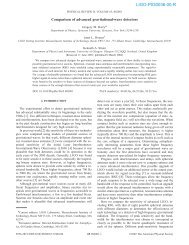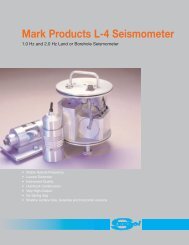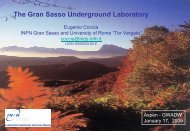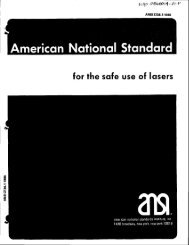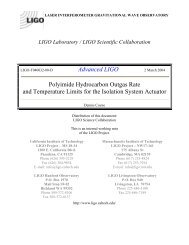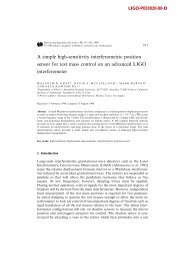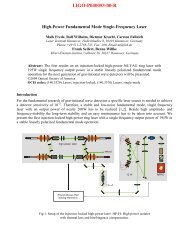P010010-00-R - LIGO - California Institute of Technology
P010010-00-R - LIGO - California Institute of Technology
P010010-00-R - LIGO - California Institute of Technology
You also want an ePaper? Increase the reach of your titles
YUMPU automatically turns print PDFs into web optimized ePapers that Google loves.
15<br />
The <strong>LIGO</strong> interferometers are large enough such that reaching the maximum<br />
storage time isn’t a problem. As a matter <strong>of</strong> fact, the bandwidth could be made much<br />
smaller, increasing the storage time. This wouldn’t be good for the integration <strong>of</strong> the<br />
signal, but it would be good for the energy stored in the detector. Increased storage<br />
time in the arms causes more <strong>of</strong> the light to be lost through the arm loss mechanisms,<br />
which are much smaller than the loss mechanisms in the power recycling cavity. The<br />
less light returning from the arms, the less efficiently light is lost due to the large<br />
power recycling losses, and the more light energy is stored. In 1993, Mizuno realized<br />
that the same signal mirror that Meers proposed to recycle the signal could be used<br />
to more efficiently “extract” the signal from a high storage time arm cavity.[27] By<br />
choosing the propagation phase defined by the signal mirror to be resonant, the band<br />
<strong>of</strong> frequencies resonant with the signal cavity transmit more efficiently, and so the<br />
storage time for signals in the arms is decreased. This is known as resonant sideband<br />
extraction, or RSE.<br />
The issue <strong>of</strong> the losses in the power recycling cavity is actually somewhat more<br />
complicated than the simple linear losses at AR coatings and scatter and absorption<br />
in the substrates. The absorption in the substrates will heat the test masses with a<br />
temperature distribution similar to the Gaussian intensity pr<strong>of</strong>ile <strong>of</strong> the beam. This<br />
temperature gradient forms a lens in the substrate via the dependence <strong>of</strong> the index<br />
<strong>of</strong> refraction on temperature. The lenses created by the substrates <strong>of</strong> the optics are<br />
sources <strong>of</strong> loss due to the fact that they change the pr<strong>of</strong>ile <strong>of</strong> the beam, causing<br />
scattering <strong>of</strong> light out <strong>of</strong> the fundamental spatial mode into higher order modes <strong>of</strong><br />
the modified cavity.[28] RSE addresses this issue simply by taking more light out<br />
<strong>of</strong> the power cavity and placing it in the arm cavities where these effects should be<br />
smaller.[25]<br />
Similar to dual-recycling, detuning the signal cavity phase away from resonance<br />
will generate frequency responses which have peak sensitivities at frequencies away<br />
from DC. Thus, RSE allows the design <strong>of</strong> a detector which can store more light in the<br />
arms, while optimizing the shape <strong>of</strong> the transfer function with respect to shot noise<br />
and the desired gravitational wave source.


